The Intel SSD 540s (480GB) Review
by Billy Tallis on June 23, 2016 9:00 AM ESTATTO
ATTO's Disk Benchmark is a quick and easy freeware tool to measure drive performance across various transfer sizes.
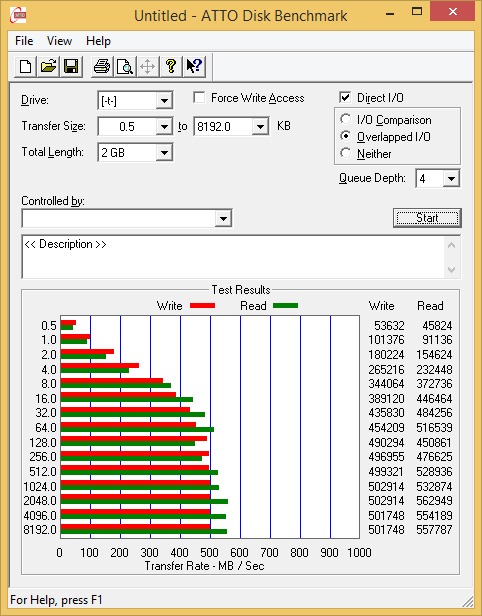 |
|||||||||
The Intel 540s's performance is a bit uneven during the ATTO benchmark, but its write speed advantage over the SP550 is still quite clear.
AS-SSD
AS-SSD is another quick and free benchmark tool. It uses incompressible data for all of its tests, making it an easy way to keep an eye on which drives are relying on transparent data compression. The short duration of the test makes it a decent indicator of peak drive performance.
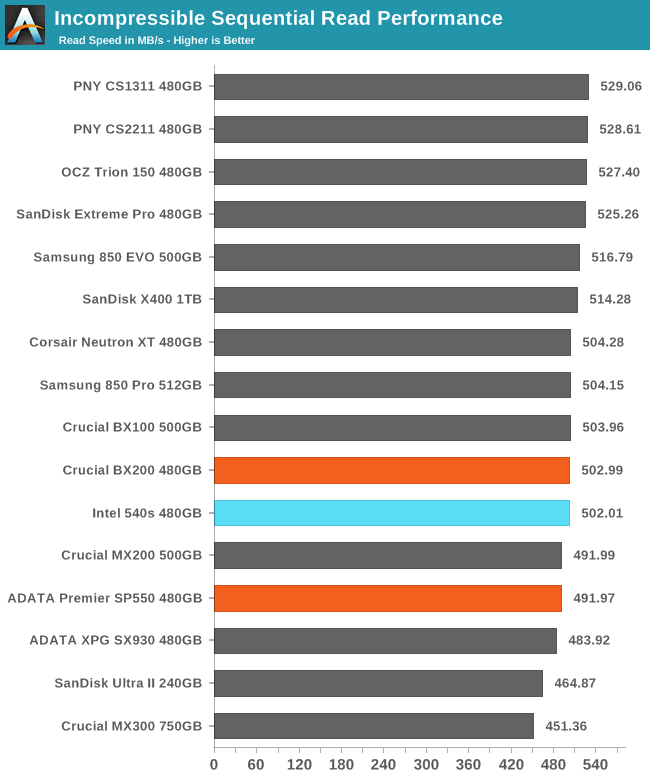
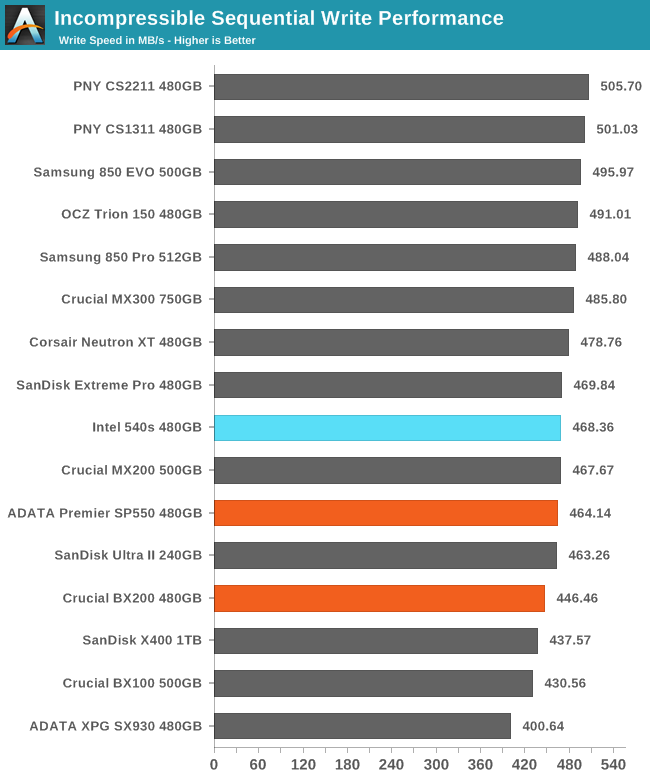
The AS-SSD test does very little to differentiate between drives, but it at least shows that the Intel 540s can reach similar peak speeds to its competition.
Idle Power Consumption
Since the ATSB tests based on real-world usage cut idle times short to 25ms, their power consumption scores paint an inaccurate picture of the relative suitability of drives for mobile use. During real-world client use, a solid state drive will spend far more time idle than actively processing commands. Our testbed doesn't support the deepest DevSlp power saving mode that SATA drives can implement, but we can measure the power usage in the intermediate slumber state where both the host and device ends of the SATA link enter a low-power state and the drive is free to engage its internal power savings measures.
We also report the drive's idle power consumption while the SATA link is active and not in any power saving state. Drives are required to be able to wake from the slumber state in under 10 milliseconds, but that still leaves plenty of room for them to add latency to a burst of I/O. Because of this, many desktops default to either not using SATA Aggressive Link Power Management (ALPM) at all or to only enable it partially without making use of the device-initiated power management (DIPM) capability. Additionally, SATA Hot-Swap is incompatible with the use of DIPM, so our SSD testbed usually has DIPM turned off during performance testing.
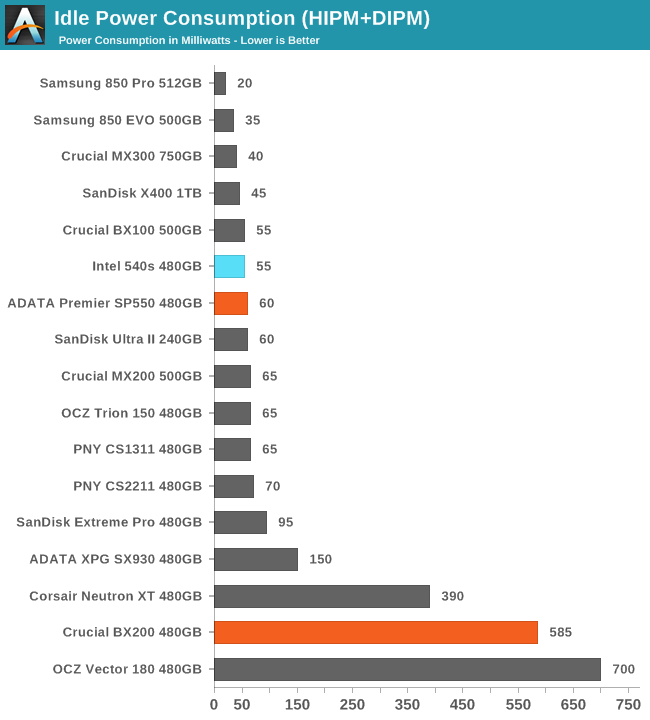
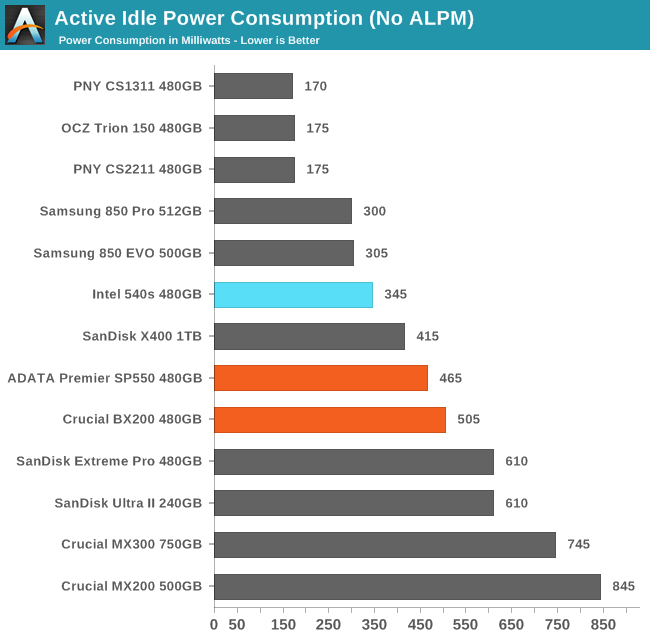
The slumber power state is working correctly on the Intel 540s and allows for very slightly lower idle power draw than the SP550. Active idle power is significantly improved over the SM2256 and is now behind only Samsung and Phison controllers. Silicon Motion's 40nm SM2258 clearly beats Marvell's 28nm 88SS1074 used in the SanDisk X400 and Crucial MX300.










77 Comments
View All Comments
Drasca - Tuesday, June 28, 2016 - link
There is a matter of scale. What is efficient for the small scale is not efficient for the large scale deployment.> even though it would probably save them a lot of dough
It wouldn't, it'd create the opposite effect costing them far more in the long run. You're thinking from the personal perspective where maintenence, reliability and security isn't an issue and non critical.
En mass, it costs them far more to have downtime, maintaining and replacing gear, than it does the initial purchase-- security notwithstanding either. They have to pay people time and money to keep the equipment up, whose price just snowballs as downtime accrues. The initial equipment cost is extremely fractional compared to the human resource cost of dealing with the equipment afterward, keeping track of it, security, physically replacing as it goes down, etc.
Buying from bulk also guarantees Hp/dell/lenovo has standardized problems and they replace the gear as it breaks wholesale. The equipment is closer to leased than purchased, with basically extended warranty guarantees. Consumer equipment does not have these protections and guarantees.
It costs far far far more in human resources spending time and money upkeeping a lot of gear that breaks, and all things will eventually break with this many pieces of equipment, taking up space that costs even more money, and causing a clusterfuck when you don't have government contracts.
The consumer level does not work at the government level and vice versa.
>entirely new workstation for that user.
They actually get entirely new workstations, for the most part. . . and old ones are worked to hell until budgets come in and approved for for upgrades across the board.
woggs - Thursday, June 23, 2016 - link
Intel doesn't ship unreliable drives (and will fix an issue if it slips out). That's the one thing you get from intel and is why they can get the big OEM orders. Other than that, I agree with "meh."trparky - Thursday, June 23, 2016 - link
For Christ's sake, why are we still using Planar NAND? Haven't we learned already that Flash memory at anything smaller than 19nm is just too unreliable? For God's sake! Everyone should be moving to 3D NAND already!trparky - Thursday, June 23, 2016 - link
Unless it's using 3D NAND, I won't buy it.ClockHound - Thursday, June 23, 2016 - link
3D? If it's not 4D, I'm not putting precious historically disposable data on it.chrcoluk - Sunday, July 17, 2016 - link
looks like its planar I am guessing by the small manufacturing size, one of the reasons ofr 3d nand is to use larger manufacturing process which has more reliable flash.16nm TLC is too scary for me.
euskalzabe - Friday, June 24, 2016 - link
Agreed. I was on the verge of buying a 512GB X400 but I think I'll wait until the fall, see what 3d NAND comes out...maxxbot - Thursday, June 23, 2016 - link
Who is this marketed for exactly? The X400 is faster AND cheaper, the 850 EVO is around the same price and much, much faster. It looks like you didn't even read the review.maxxbot - Thursday, June 23, 2016 - link
As for the reputable company comment, there's already a very reputable company out there that produces drives with much better price/performance: Samsung. Every corporate laptop I have had has had a Samsung SSD, why would they choose lower performance and higher price to go with this drive?alpha754293 - Monday, July 25, 2016 - link
Sadly though, my Intel 520 series SSDs performed better in random I/O (swapping) than this *NEW* Intel 540 series drive.The ONLY thing that has changed is cost. (I can buy a 1 TB 540 series drive at Microcenter for $250, and therefore; the $/GB has come down a LOT since the 520 series days), but for a 5-series drive, it certainly doesn't have the performance to match.
This was the same problem that I had with the 535 Series as well.
Whyyy would you release a NEW product that's actually inferior in measurable performance?
You would think that when you're buying a NEW drive, that you're getting the best that the company has to offer at this level. (Yes, I also have a 750 series PCIe x4 SSD as well, in case you were wondering (or not).)